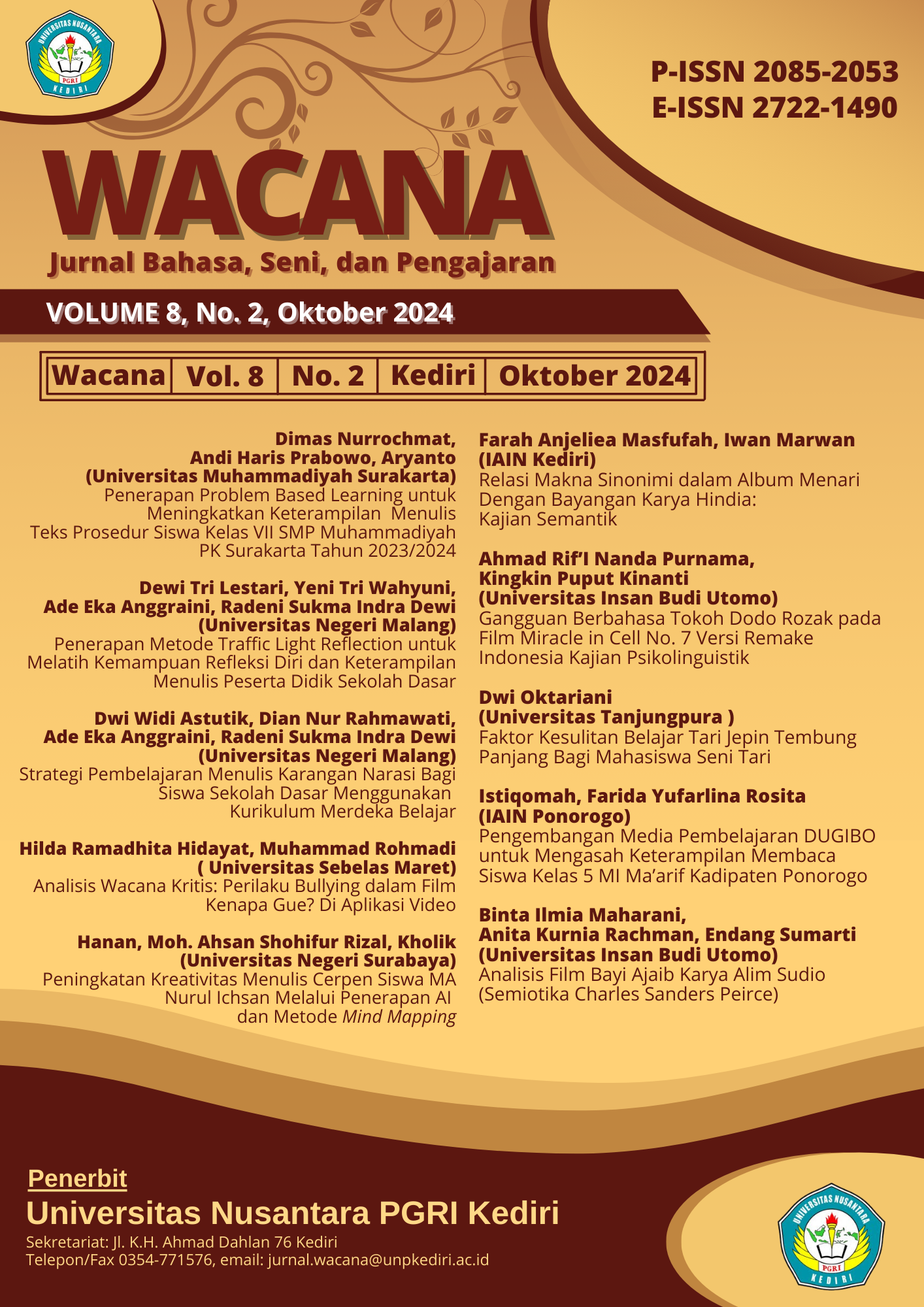Penerapan Metode Traffic Light Reflection untuk Melatih Kemampuan Refleksi Diri dan Keterampilan Menulis Peserta Didik Sekolah Dasar
Application of the Traffic Light Reflection Method to Train Skills Self-Reflection and Writing Skills of Elementary School Students
DOI:
https://doi.org/10.29407/jbsp.v8i2.22601Keywords:
self reflection, traffic light reflection, writing skillsAbstract
Writing skills in elementary school are activities that encourage students to develop their academic and cognitive abilities. For this reason, it is necessary to apply a method that is able to provide a significant impact. For example, by applying the Traffic Light Reflection method. The aim of this research is to determine the phenomena that occur in research subjects holistically, namely by describing the conditions encountered when applying the Traffic Light Reflection method to train self-reflection abilities and writing skills. This study used descriptive qualitative method. The data source in this research is class IV students at SD Negeri 2 Kates, Kauman District, Tulungagung Regency. The research results show that the Traffic Light Reflection method can facilitate students to write reflections during learning and reflect on learning outcomes. The use of traffic light color analogies is easy for students to understand so that students do not find it difficult to fill in the reflection sheet. Applying this method, students can evaluate and assess themselves.
References
Agustin, P. H., & Indihadi, D. (2020). Analisis keterampilan menulis teks prosedur siswa kelas iv. PEDADIDAKTIKA: Jurnal Ilmiah Pendidikan Guru Sekolah Dasar, 7(2), 83–92. https://doi.org/10.17509/pedadidaktika.v7i2.26373
Ambarita, J., & Simanullang, P., S. (2023). Implementasi pembelajaran berdiferensiasi (A. C. Dewi (ed.)). Penerbit Adab.
Andrade, H., & Valtcheva, A. (2009). Promoting learning and achievement through self-assessment. Theory Into Practice, 48(1), 12–19.
Badan Standar Kurikulum dan Asesmen Pendidikan. (2022). Surat keputusan kepala badan standar kurikulum dan asesmen pendidikan nomor 008/KR/2022 tentang capaian pembelajaran pada paud, jenjang pendidikan dasar dan jenjang pendidikan menengah pada kurikulum merdeka.
Black, P., Harrison, C., Lee, C., Marshall, B., & William, D. (2002). Working inside the black box: Assessment for learning in the classroom. Phi Delta Kappan, 86(1), 8–21.
Foundation, T. (2022). Modul memahami pembelajar mandiri.
Foundation, T. (2023). Manfaat kebiasaan refleksi diri bagi pendidik dan peserta didik.
Guru, T. B. K. (2007). Bina bahasa Indonesia. Erlangga.
Kurniasari, N., Permadi, I., & Purbasari, K. H. (2024). Refleksi guru pada pembelajaran berdiferensiasi di sekolah dasar teacher reflection on differentiated learning in primary school. 5(September), 187–198. https://doi.org/10.30595/jrpd.v5i2.21877
Marlina. (2019). Panduan pelaksanaan model pembelajaran. Book, 63.
Maulina, H., Hariana Intiana, S. R., & Safruddin, S. (2021). Analisis kemampuan menulis cerpen siswa sekolah dasar. Jurnal Ilmiah Profesi Pendidikan, 6(3), 482–486. https://doi.org/10.29303/jipp.v6i3.276
Moleong, L. J. (2010). Metodologi penelitian kualitatif. PT Remaja Rosdakarya.
Moon, J. A. (1999). Reflection in learning and professional development: Theory and practice. Kogan Page.
Munna, A. S. (2021). Self-control using traffic lights toolkit for academic success. Advances in Social Sciences Research Journal, 8(12), 93–95.
Oishi, I. R. V. (2020). Pentingnya belajar mandiri bagi peserta didik di perguruan tinggi. Jurnal IKRA-ITH Humaniora, 4(2), 50–55.
Opriș, M. (2011). Religie, morală, educație. Perspective teologice și pedagogice [Religion, morality, education. theological and pedagogical perspectives]. Editura Basilica a Patriarhiei Române.
Ramdani, N. G., Fauziyyah, N., Fuadah, R., Rudiyono, S., Septiyaningrum, Y. A., Salamatussa’adah, N., & Hayani, A. (2023). Definisi dan teori pendekatan, strategi, dan metode pembelajaran. Indonesian Journal of Elementary Education and Teaching Innovation, 2(1), 20. https://doi.org/10.21927/ijeeti.2023.2(1).20-31
Stan, L. (2021). The “Traffic light” method in the context evaluation self evaluation of preschoolers. Acta Didactica Napocensia, 14(1), 208–213. https://files.eric.ed.gov/fulltext/EJ1309202.pdf
Stephanie. (2022). Traffic light reflection and goal setting. https://www.thecoachingsketchnotebook.com/2021/01/traffic-light-reflection-and-goal.html
Sumaryanta, Pradjitno, E., & Agustina, T. (2017). Modul pengembangan keprofesian berkelanjutan: Refleksi pembelajaran dan tindak lanjutnya melalui ptk.
Tarigan, H. G. (2008). Menulis sebagai suatu keterampilan berbahasa. Angkasa.
Vania, E. P., & Rizal, M. A. S. (2024). Inovasi pendidikan: Menerapkan konsep inklusi dalam pembelajaran bahasa Indonesia untuk mewujudkan kemandirian dan keberagaman siswa. Wacana : Jurnal Bahasa, Seni, Dan Pengajaran, 8(1), 1–10. https://doi.org/10.29407/jbsp.v8i1.21511
Warsiman. (2010). Bahasa Indonesia: Teori dan aplikasi. Universitas Negeri Surabaya University Press.
Yarmi, G. (2017). Pembelajaran menulis di sekolah dasar. Perspektif Ilmu Pendidikan, 31(1), 1–6. https://doi.org/10.21009/pip.311.1
Zulela, M. (2017). Keterampilan menulis narasi melalui pendekatan konstruktivisme di sekolah dasar. Jurnal Pendidikan Dasar, 8(2), 112–123.
Downloads
Published
Issue
Section
License
Copyright (c) 2024 Dewi Tri Lestari, Yeni Tri Wahyuni, Ade Eka Anggraini, Radeni Sukma Indra Dewi

This work is licensed under a Creative Commons Attribution-ShareAlike 4.0 International License.













